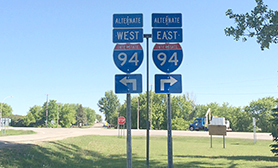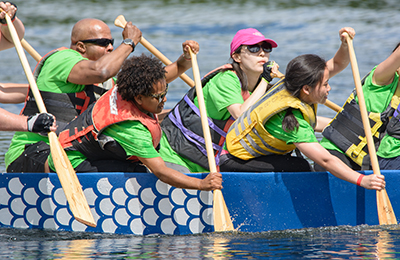 |
|

|
|

|
 |
TABLE of CONTENTS
 |
District 4 implements alternate highway signs |
By Jerimiah Moerke, District 4 public affairs coordinator

District 4 is installing alternate Interstate 94 signs to help drivers bypass incidents on the interstate. Photo by Jerimiah Moerke |
District 4 is installing alternate Interstate 94 signs along designated routes in west central Minnesota.
The signs are intended to help interstate traffic bypass incidents such as crashes and spills. By implementing a system of coordinated and pre-designated alternate routes, the time needed to clear the roadway can be reduced, and secondary crashes can be minimized. In addition, using predetermined routes will help lessen the demand on local law enforcement in an emergency situation.
“There are a limited number of law enforcement officers available at one time in west central Minnesota,” said Capt. Brian Cheney, Minnesota State Patrol. “These predetermined routes and signs will help us focus our resources where they are needed the most during major incidents.”
The routes will be used only when I-94 will be fully blocked for an extended period of time due to an emergency. They will not be used during extended winter interstate closures.
All of the designated routes are near I-94.
MnDOT consulted with city and county engineers, Minnesota State Patrol, the North Dakota Department of Transportation, North Dakota Highway Patrol, county law enforcement and local Emergency Medical Services in determining the routes.
“By putting in the work ahead of an emergency, all agencies can make quicker, more consistent decisions to keep traffic moving safely,” said Kohl Skalin, District 4 project manager.
This is the first signing effort of its kind in the state of Minnesota, but other states have implemented similar alternate route systems. |
 |
|

|
 |
TABLE of CONTENTS
 |
Study shows reduced conflict intersections are lowering number of traffic deaths, injuries |
|
By Sue Roe
|
Reduced conflict intersections are an engineering solution that reduces fatalities and injuries caused by broadside crashes on four-lane divided highways. This video explains how they work. Video produced by MnDOT Video Services |
A new safety study by MnDOT shows that the state’s Reduced Conflict Intersections are saving lives.
RCIs are intersections on multi-lane highways. They allow drivers to turn right from the smaller, local roadway onto the higher speed road and make a u-turn at a nearby opening in the median. They prohibit drivers from making left turns onto the highway.
Historically, these intersections, without the RCI design, have more severe right-angle crashes than most other intersections.
The study shows that eight RCIs studied in Minnesota had a 100 percent reduction of fatal and serious injury right-angle crashes, a 77 percent reduction of all severity right-angle crashes and a 50 percent reduction of injury crashes. The state has four other RCIs, not included in the study, and those intersections have not had a serious injury nor fatality since construction.
“RCIs prevent drivers on the minor road from exposing themselves to the most common type of severe crash, the right-angle crash,” said Derek Leuer, assistant state traffic safety engineer. “Drivers complete a series of driving maneuvers that reduce their probability of a severe crash and the risk of a death or serious injury.”
Leuer said the findings in the study are consistent with other studies done throughout the U.S.
“The reduced conflict intersection is gaining in public acceptance and is the more widely applied option for intersections at four-lane divided highways,” he said. “When crashes do occur, the injury level is typically lower than at standard intersections.”
MnDOT has plans to build at least 20 more RCIs in the next five years. The first one in the state was built in 2010 in Willmar.
“Reduced conflict intersections have firmly shown to reduce deaths, injuries and crashes. That’s why we want to keep building them,” he said. “The other benefits are that they are faster to build and cost less than a typical interchange.”
The study is online. For more information on RCIs, go to www.mndot.gov/roadwork/rci/. |
 |
|

|
|

|
 |
TABLE of CONTENTS
 |
Employees help reduce shared drive space during spring cleanup week |
|
By Charles Stech, Office of Chief Counsel

Bill Gardner, Office of Freight and Commercial Vehicle Operations director, and Anna Craig, OFCVO office and administrative specialist, received the Golden Hard Drive for OFCVO having the highest percentage of reduced space on its shared drive. Photo by Rich Kemp |
The winner of this year’s shared drive reduction initiative is the Office of Freight and Commercial Vehicle Operations. The office reduced its shared drive by 17.28 percent, the highest percentage of reduction the last week of June. Honorable mentions go to the Office of Civil Rights, and to District 8, the district with the greatest reduction.
“In order to reduce our office's data usage, OFCVO units and employees were asked to carefully review network folders and files,” said Anna Craig, office and administrative specialist. “We were able to eliminate duplicate files that were located in multiple locations, as well as outdated forms that are no longer used. In one case, we were able to remove a significant amount of old field photos in one of our program areas. Our success in data reduction was due to the diligence of each employee in taking the time to review their files, and this award recognizes that effort.”
“Thank you to all the offices and districts who worked hard to reduce their email storage footprint,” said Jennifer W. Witt, records and information manager. “It is a lot of effort and it does help the organization. It was a learning process. We will do the Spring Clean Up earlier next year based on feedback from this time around.”
Up next on the clean-up front: “December of Destruction.” During the entire month of December, MnDOT will delete ROT (redundant, obsolete, trivial) email. More to come in upcoming months. |
 |
|

|
 |
TABLE of CONTENTS
 |
New updates occur for RCA, EIOR |
MnDOT now has separate appropriations in SWIFT for each product and service. The changes began July 1. These products and services appropriations will be referenced as “child appropriations” to a “parent appropriations” (examples are T790081 and T790083). Using child appropriations for the products and services will help MnDOT to budget, plan, spend and report with enhanced transparency by product and service.
What does this mean for employees?
Employees may see the new child appropriations in RCA on timesheets and in EIOR. Changes to funding in RCA and EIOR may be automatic, if there is an allowable funding combination. Both RCA and EIOR have edits that “look up” and change the appropriation, if the funding combination matches a child appropriation. The change may not apply to every appropriation or even on every funding line. It will depend on the other coding combination. If you see the appropriation change, don’t worry. Just leave it as it appears. Your time or purchase will now use that new appropriation.

This example shows how the appropriation will automatically change when the employee enters their information. |
In RCA the automatic funding change will happen after you save, validate, or complete the timesheet. In EIOR the automatic funding change will happen when you validate the funding information.
To help employees with the new product and service child appropriations, there is a quick reference guide that describes the changes. It’s posted on the RCA home page and linked here: Product and Service Appropriations.
There will also be monthly webinars on MnDOT’s Products and Services. Find dates and registration instructions on iHUB at the Products and Services Training page.
For help with the new appropriations and entering them into RCA or your business expense form, contact MN_DOT_Financial Support. |
 |
|

|
 |
TABLE of CONTENTS
 |
Employees compete in annual Dragon Boat Races |
By Dana Hernandez

MnDOT employees participate in the Dragon Boat Races July 8 in St. Paul. Photo by David Gonzalez |
MnDOT participated in the Dragon Boat Races held at St. Paul’s Lake Phalen July 8. The boat races are part of an annual Dragon Festival, which honors Pan-Asian heritage.
MnDOT has been participating in the races for at least eight years, according to captains Sophia Xiong-Yang and Mary Young, both from the Office of Diversity and Inclusion.
The agency’s participation is sponsored by the Asian Employee Resource Group, whose values and missions align with those of the Dragon Festival.
The festival’s goals are to “build bridges between the various Asian-Pacific communities, as well as among them and the wider social fabric of Minnesota by providing friendly competition through a dragon boat race.”
As MnDOT strives to create a more diverse and inclusive working environment, ERGs help to facilitate that goal. The Asian ERG serves as an employment and information resource for both internal staff and external populations of Asian origin and heritage.
“This is a great opportunity for MnDOT employees to get outside of the office to network and build positive relationships with each other and the community,” said Xiong-Yang. “Of course, winning would be a bonus, but it’s much more than that. We are building a stronger agency and actively recruiting at the festival.”

From left, Gary Banks, CO admin; Tigest Mamo, Metro District transportation generalist; Shuo Wang, Metro District traffic; and Kao Soua Yang, Metro District student worker, paddle for the MnDOT team during the Dragon Boat Races. Photo by David Gonzalez |
Unfortunately, MnDOT didn’t place in this year’s competition, but the captains were excited that there were many new paddlers who volunteered and that MnDOT's timing was better than last year.
“I could hand-pick my team with experienced, veteran paddlers so that we have a better chance of winning if that was the objective. We don’t do that for obvious reasons. It’s all about diversity, inclusion and trying new things,” said Xiong-Yang.
The boat race has specific guidelines for teams. For example, a minimum of eight female paddlers are necessary, which can sometimes be difficult to come up with.
The Snow Dragon’s team included:
- Central Office: Gary Banks, Kelsey Baumann, Anthony Cenci, Dana Hernandez, Rick Kostohryz, Chad Lochungvu, Linda Pate, Alexia Rooney, Kao Soua Yang, Thomas Styrbicki and Zue Vue
- Duluth: Holly Kostrzewski
- Maplewood: Hossana Teklyes
- Metro: Tigest Mamo, Christy Miranda and Shuo Wang
- Oakdale: Aislyn Ryan
- Rochester: Kristine Hernandez
- Spring Lake Park: James Xiong
“I wasn’t sure what I was getting myself into when I signed up,” said Holly Kostrzewski, NE/NW Minnesota Toward Zero Deaths regional coordinator. “It was a challenge, but it was fun to meet other MnDOT employees that I wouldn’t have otherwise met.”
To become involved in next year’s Dragon Boat Race, watch for a summer 2018 recruitment note mailer. Don’t worry; no experience is necessary. |
 |
|
| |
|



